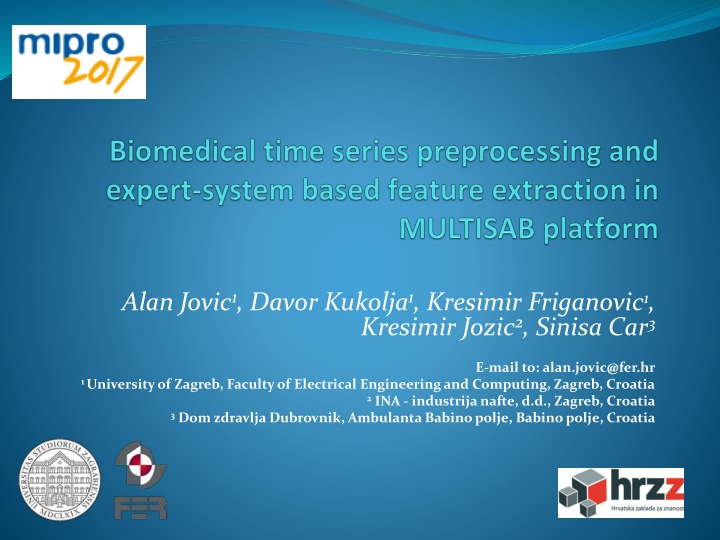
Medical Expert System for Web-Based Disease Classification
"Explore the development of a web-based system for automatic classification of human body disorders through the analysis of biomedical signals. Enhance diagnostics and early detection of diseases with expert features and predefined analysis scenarios. Stay updated on the evolving MULTISAB expert system and its implementation in the healthcare community."
Download Presentation

Please find below an Image/Link to download the presentation.
The content on the website is provided AS IS for your information and personal use only. It may not be sold, licensed, or shared on other websites without obtaining consent from the author. If you encounter any issues during the download, it is possible that the publisher has removed the file from their server.
You are allowed to download the files provided on this website for personal or commercial use, subject to the condition that they are used lawfully. All files are the property of their respective owners.
The content on the website is provided AS IS for your information and personal use only. It may not be sold, licensed, or shared on other websites without obtaining consent from the author.
E N D
Presentation Transcript
Alan Jovic1, Davor Kukolja1, Kresimir Friganovic1, Kresimir Jozic2, Sinisa Car3 E-mail to: alan.jovic@fer.hr 1 University of Zagreb, Faculty of Electrical Engineering and Computing, Zagreb, Croatia 2INA - industrijanafte, d.d., Zagreb, Croatia 3Dom zdravlja Dubrovnik, Ambulanta Babinopolje, Babinopolje, Croatia
CONTENT Motivation & goal Predefined analysis scenarios with expert features A. Acute Myocardial Ischemia B. Atrial Fibrillation C. Congestive Heart Failure Preprocessing Featureextraction Conclusion 2/17
Motivation & goal In recent years, the need for web-based biomedical software is continuoslygrowing in the healthcare community: The need to reduce the cost of healthcare expenditure in developed countries 2) To facilitate access to a better healthcare 1) Goal: developmentof a web-based system for automatic classification of human body disorders based on the analysis of biomedical signals Recommendations to medical specialists in diagnostics and early detection of various diseases 3/17
Scenarios for platform use The data analysis process is divided into 8 steps: Analysis type selection 1. 2. Scenario selection 3. Input data selection 4. Records inspection 5. Records preprocessing 6. Feature extraction 7. Model construction 8. Reporting Analysis type selection Scenario selection 5/17
Predefined analysis scenarios with expert features Scenario selection UI enables the user to select: Predefined scenario 1. 2. Construction of a completely new scenario through full customization The predefined scenarios contain necessary preprocessing steps and expert features that are to be extracted from signals, which are selected by the medical expert system specifically designed for this purpose 6/17
MULTISAB expert system Implementation of the medical expert system is a continuously evolving process that gradually introduces new predefined scenarios New scenarios are based on currently valid medical guidelines, standards, consultations with medical specialists, and relevant medical and biomedical engineering literature MULTISAB expert system includes the recommended features for detection of: Acute myocardial ischemia (AMI), Atrial fibrillation (AF), Congestive heart failure (CHF) 1. 2. 3. 7/17
Diagnosis of Acute Myocardial Ischemia According to the medical guidelines, criteria for diagnosis of AMI (in absence of left ventricular hypertrophy and left bundle branch block) are: 1. ST elevation: New ST elevation at the J point in two contiguous leads, 2. ST depression and T wave changes: New horizontal or down- sloping ST depression in two contiguous leads and/or T wave inversion in two contiguous leads with prominent R wave or R/S ratio >1 8/17
Acute Myocardial Ischemia: Expert ECG features Morphological ECG features: ECG signal value (in regard to the baseline) at the J point, R/S ratio, T wave amplitude, and ST segment slope Dynamical ECG features: standard deviation of ECG signal value at the J points HRV features: LF, HF QTV features: QTVnorm, QTVI Additional expert features, which demand expanding the current frameworks, could include: Calculation of energy and entropy measures in wavelet domain Additional information in the ST segments, such as shape, width, height, curvature, etc. 9/17
Atrial Fibrillation According to the medical guidelines, and with up to date medical research, AF is associated with the following changes in ECG: 1. Lack of discrete P waves 2. Fibrillatoryor f waves are present at a rate that is generally between 350 and 600 beats/minute 3. Ventricular response follows no repetitive pattern; the variability in the intervals between QRS complexes is often termed irregularly irregular 4. The ventricular rate, especially in the absence of AV nodal blocking agents or intrinsic conduction disease, usually ranges between 90 and 170 beats/min 5. The QRS complexes are narrow, unless AV conduction through the His Purkinje system is abnormal due to functional (rate- related) aberration, pre-existing bundle branch or fascicular block, or ventricular preexcitation with conduction down the accessory pathway 10/17
Atrial Fibrillation: Expert ECG features Morphological ECG features: P wave absence, fibrillatory rate, QRS complexes duration Short-term HRV features : Heart rate, SDNN, RMSSD, pNN50, LF, HF, LF/HF ratio, approximate entropy (ApEn), sample entropy (SampEn) Long-term HRV features : Total power spectral density (TP), VLF, 1/f power-law exponent Additional expert features, which demand expanding the current frameworks, could include calculation of wavelet entropy (WE) or relative wavelet energy (RWE) Based on the wavelet transformation of the TQ interval 11/17
Congestive Heart Failure ECG manifestations of CHF are unspecific In the guidelines there is only a statement that an abnormal ECG increases the likelihood of the diagnosis of CHF The medical diagnosis of CHF is based on presenting signs and symptoms, patient s prior clinical history, physical examination and resting ECG If all the elements are normal, CHF is highly unlikely If at least one element is abnormal, plasma natriuretic peptides (NPs) should be measured, to identify those who need echocardiography Echocardiography is the most useful and widely available test in patients with suspected CHF used to establish the diagnosis 12/17
Congestive Heart Failure : Expert ECG features Morphological ECG features: Q wave amplitude, PR interval duration, P peak amplitude, R peak amplitude, QRS complex duration, ratio of QT segment and heart rate corrected QT segment (QT/QTc), S wave duration in leads I, V5, V6, V1 and V2, R wave duration in leads V5 and V6 Short-term HRV features: Heart rate, short term detrended fluctuation analysis coefficient 1 (DFA 1), symbolic dynamics one variation pattern (1VP), LF, SDNN Long-term HRV features: VLF, 1/f power-law exponent Although some features of heart rate turbulence (HRT), such as turbulence slope (TS), have significant predictive value, they are not used in the expert system because they cannot be calculated from all ECG recordings 13/17
Preprocessing Records preprocessing assumes various procedures for: Signal filtering, Characteristic waveform detection, Data transformations 14/17
Feature extraction Central step in the analysis of biomedical time-series Feature extraction UI for AF detection analysis scenario 15/17
Conclusion Progress report of the work on an innovative web platform for biomedical time-series analysis Description of an expert feature recommendation system for ECG analysis through predefined analysis scenarios Initial version of the MULTISAB expert system includes the detection of AMI, AF, and CHF from ECG signals. We expect that in a few months a fullyoperational version will be available in Croatian and in English The functionalitywill be limited to the first six steps, ending with the possibility of calculated featuresdownload, thus enabling further independentdata mining and reporting 16/17
Thank you! Questions? This work has been fully supported by the Croatian Science Foundation under the project number UIP- 2014-09-6889: A software system for parallel analysis of multiple heterogeneous time series with application in biomedicine (MULTISAB) 17/17







